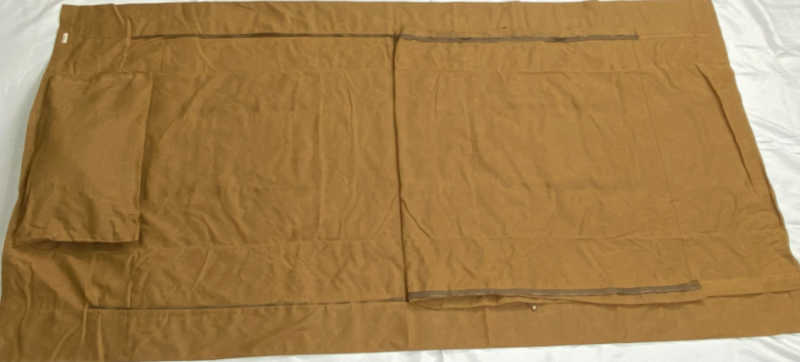
Wax Canvas Bedroll VS Sleeping Bag
Let Chat about Wax Canvas Bedrolls VS Sleeping Bags. In this article we will go over some history, functionality, pros and cons, as well what happens when you combine the two!
Wax canvas bedrolls and sleeping bags serve similar purposes but have some distinct differences in design, functionality, and usage.
Material:
Wax Canvas Bedrolls are made from durable waxed canvas, which is a heavy-duty cotton fabric treated with wax for water resistance and durability.
Sleeping Bags made from synthetic materials like nylon or polyester, often with insulation (down or synthetic) for warmth.
Design:
Wax Canvas Bedrolls are "usually" a simple rectangular piece of waxed canvas that can be rolled up and tied. It may have straps or buckles for securing it.
Sleeping Bags are a form-fitting, zippered bag with insulation and often a hood for warmth. It envelops the sleeper.
Versatility:
Wax Canvas Bedrolls serve multiple purposes such as a ground cloth, shelter, or even as a makeshift stretcher if needed. Can be used with a separate sleeping pad or mattress for comfort.
Sleeping Bags are primarily designed for sleeping, though some models can be unzipped fully and used as blankets or partially unzipped for ventilation.
Warmth:
Wax Canvas Bedrolls offer minimal insulation on its own. Its primary purpose is protection from moisture and wind.
Sleeping Bags are designed to provide insulation and retain body heat, making it more suitable for cold weather camping.
Portability:
Wax Canvas Bedrolls can be bulkier and heavier compared to a sleeping bag, depending on the material and size.
Sleeping Bags are typically lightweight and compact, designed for easy transportation in a backpack.
Durability:
Wax Canvas Bedrolls are known for their ruggedness and longevity. With proper care, a wax canvas bedroll can last for many years.
Sleeping Bags while durable, sleeping bags may be more susceptible to tears or damage, particularly if not handled carefully.
Maintenance:
Wax Canvas Bedrolls require occasional reapplication of wax to maintain water resistance. Can be spot cleaned or hand washed if needed.
Sleeping Bags are generally easy to clean, often machine washable. Down-filled sleeping bags may require special care.
To sum it all up...the choice between a wax canvas bedroll and a sleeping bag depends on factors such as personal preference, intended use, climate conditions, and camping style. The wax canvas bedroll might be favored for its versatility and durability, while the sleeping bag excels in providing warmth and compactness for backpacking trips.
Now let's step into some bedroll history briefly....
The history of waxed canvas bedrolls traces back to the early days of human civilization when people began using primitive materials to protect themselves from the elements while sleeping outdoors. However, the specific development of waxed canvas bedrolls as we know them today has roots in the 19th and early 20th centuries.
Origins of Canvas:
Canvas itself has a long history, dating back thousands of years. It was originally made from hemp fibers and used by ancient civilizations for sails, tents, and clothing due to its durability and strength.
Wax Treatment:
The practice of treating canvas with wax for water resistance likely evolved over time as people sought to enhance the performance of their canvas shelters and gear. This process involved applying wax, often beeswax or paraffin, to the canvas fabric to create a waterproof barrier.
Military and Outdoor Use:
Waxed canvas bedrolls gained popularity among military personnel and outdoor enthusiasts during the 19th and early 20th centuries. Soldiers and pioneers appreciated their durability, weather resistance, and versatility in various outdoor conditions.
Industrial Revolution:
The Industrial Revolution brought advancements in textile manufacturing, allowing for the mass production of canvas and other fabrics. This made waxed canvas bedrolls more accessible to the general population.
Role in Exploration and Adventure:
Waxed canvas bedrolls became indispensable for explorers, adventurers, and frontiersmen who traversed rugged terrains and endured harsh weather conditions. They provided a portable and reliable shelter option for those on expeditions into the wilderness.
Modern Era:
In the modern era, waxed canvas bedrolls continue to be valued for their durability, classic aesthetic, and practicality. While synthetic materials have become prevalent in outdoor gear, waxed canvas remains a preferred choice for many outdoor enthusiasts, survivalists, and bushcraft practitioners due to its natural feel and rugged performance.
Contemporary Use:
Today, waxed canvas bedrolls are still used by campers, hikers, hunters, and others who appreciate their traditional charm and functionality. They are often combined with modern materials and design features to enhance performance while maintaining the timeless appeal of waxed canvas.
The history of waxed canvas bedrolls reflects the evolution of outdoor shelter and gear, highlighting the enduring appeal of simple yet effective solutions for sleeping outdoors in comfort and protection.
Let's Put It All Together...
A sleeping system inside a bedroll typically consists of the components needed to ensure a comfortable and restful night's sleep outdoors. While the specific setup can vary based on personal preferences, climate conditions, and the type of bedroll being used, a typical sleeping system inside a bedroll may include:
Sleeping Pad or Mattress:
A sleeping pad or mattress provides insulation and cushioning between the sleeper and the ground. It helps prevent heat loss to the ground and adds comfort by providing a soft surface to sleep on.
Inflatable sleeping pads or foam camping mattresses are commonly used for their lightweight and packable nature. Some campers prefer self-inflating pads for the convenience they offer.
Sleeping Bag or Blanket:
A sleeping bag or blanket is essential for warmth, especially in colder climates or seasons. It traps heat close to the body and provides insulation against cold air.
Down-filled or synthetic sleeping bags are popular choices for their warmth-to-weight ratio and compressibility. Alternatively, some campers may opt for blankets or quilts, particularly in milder conditions.
Pillow:
A pillow or improvised pillow (such as a stuff sack filled with clothing) adds neck support and enhances overall comfort during sleep. It's a small but significant component of the sleeping system.
Additional Insulation (if needed):
In extremely cold conditions, additional insulation may be necessary to supplement the sleeping bag's warmth. This can include insulated jackets, vests, or even emergency blankets placed inside the sleeping bag.
Sleeping Bag Liner (optional):
A sleeping bag liner can add warmth to the sleeping system and also helps keep the sleeping bag clean. Liners are available in various materials, including silk, cotton, and synthetic fabrics.
Personal Items:
Personal items such as a headlamp, earplugs, and a book may also be included in the bedroll for convenience and entertainment during downtime.
Organizational Pouches or Compartments:
Some bedrolls come with built-in pockets or compartments for organizing small items like keys, phones, or toiletries.
Overall, a well-prepared sleeping system inside a bedroll enhances comfort, warmth, and overall enjoyment of outdoor adventures.
If you are looking for a high quality Wax Canvas Bedroll, Check out 17/90 Survivals Bedroll at an affordable price point and the highest level of quality you have nothing to lose and everything to gain. Preserve the life of your sleep system with a was canvas bedroll today!
https://betterbushcraft.com/collections/17-90-survival/products/17-90-survival-bedroll-waxed-canvas

